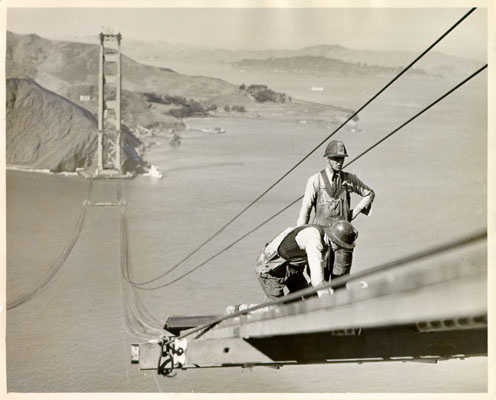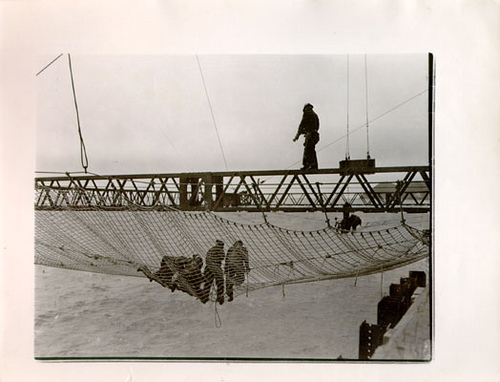Construction on The Golden Gate Bridge (named after the Golden Gate strait at the entrance of San Francisco Bay) began on January 5, 1933. It took a little over 4 years to complete and the Bridge was open to vehicular traffic on May 28, 1937. At that time it was the longest suspension bridge in the world. It would retain that title until the Verazzano Bridge in New York City was built in 1961.
The pictures give you an idea of how crazy a job the workers had. 100's of feet above the water with battering winds standing on half finished structures. Just nuts!
They Said It Couldn't Be Built
Back in the 1920's and 30's, building something like the Golden Gate Bridge seemed impossible. Some background from CEG:
The mind-boggling idea of spanning this entrance to San Francisco’s harbor enticed people’s imaginations for years. San Francisco was growing fast, and Marin County, 1 mi. across the water, had tremendous potential.
Connecting the two would be a huge boon for the entire area. San Francisco was the largest American city still served primarily by ferry boats. Lacking a permanent link with communities around the bay, the city’s growth rate was below the national average.
Bridging the strait, however, was a daunting challenge.
Many engineering and construction experts said the bridge couldn’t be built. The strait is 6,700 ft. (2,042 m) wide. It’s really a gap in a mountain range, a gorge fronting directly on the Pacific Ocean, producing strong, swirling tides and currents, with water 335 ft. deep at the center of the channel, and almost constant winds of 60 mph.
The bridge would be broadside to ferocious winds and would often be surrounded by blinding fogs during construction and operation. It also would be within 12 mi. (19 km) of the geological fault whose shifting had rumbled through San Francisco in 1906, shaking down bridges and thousands of other structures.
No bridge had ever been built before at a harbor entrance; the structure would have to be tall enough to allow the largest ships to pass underneath its deck at high tide.
Here's some pictures of the bridge during the construction.
Despite Rigorous Safety Standards 11 Workers Died
This safety net was under the bridge to catch anyone who may fall. 19 people were saved this way.
They called themselves the "Half-Way -to-Hell Club".
The California Historian outlines the safety steps taken to save workers lives:
During construction, Strauss (the designer) insisted on the use of the most rigorous safety precautions in the history of bridge building (Knapp 18). Edward W. Bullard, a local manufacturer of safety equipment, designed protective headgear that Strauss insisted be worn on the job. This was the prototype of the hard hat, worn for the first time in history, along with glare-free goggles. Special hand and face cream protected the workers against the wind and sun, while special diets helped fight dizziness due primarily to alcohol abuse (Thoma).
The most conspicuous precaution was the safety net, suspended under the bridge from end to end. During construction, the net saved the lives of 19 men who became known as the "HalfWay-to-Hell Club." Until February 17, 1937 there had been only one fatality, setting a new all-time record in a field where "one life lost for every million dollars spent…" was the norm (Brown 153-161). Tragically, on the 17th of February, 10 men lost their lives when a section of a scaffold, used to spin wire into cable, carrying 12 men fell through the safety net.(9) The safety standards put into effect by Strauss on the Golden Gate Bridge project are now an accepted part of the nation's construction regulations.
History Channel Documentary
The History Channel did a "Modern Marvels" documentary on the bridge. It is pretty good.
The Bridge Today
The Golden Gate remains an iconic part of the San Francisco/Oakland skyline. Here's some great shots from a Flickr group.
Images from the San Francisco Public Library on Flickr

